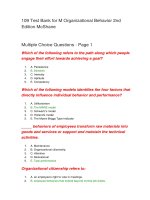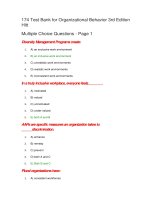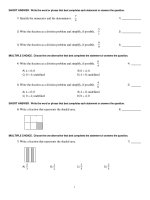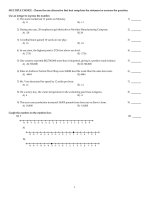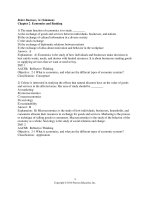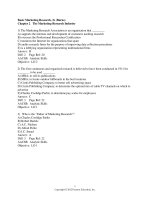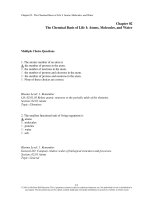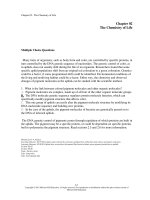M organizational behavior 3rd edition mcshane test bank
Bạn đang xem bản rút gọn của tài liệu. Xem và tải ngay bản đầy đủ của tài liệu tại đây (344.23 KB, 72 trang )
Chapter 02 - Individual Behavior, Personality, and Values
Chapter 02
Individual Behavior, Personality, and Values
True / False Questions
1. According to the MARS model of individual behavior and performance, employee
performance will remain high even if one of the four factors—motivation, ability, role
perceptions, and situational factors—is low in a given situation.
FALSE
All four factors in the MARS model are critical influences on an individual's voluntary
behavior and performance; if any one of them is low in a given situation, the employee would
perform the task poorly.
AACSB: Analytic
Accessibility: Keyboard Navigation
Blooms: Remember
Learning Objective: 02-01 Describe the four factors that directly influence individual behavior and performance.
Level of Difficulty: 1 Easy
Topic: MARS Model of Individual Behavior and Performance
2. The MARS model identifies the four main factors that influence individual behavior—
motivation, ability, role perceptions, and situational factors.
TRUE
The MARS model identifies the four main factors that influence individual behavior—
motivation, ability, role perceptions, and situational factors.
AACSB: Analytic
Accessibility: Keyboard Navigation
Blooms: Remember
Learning Objective: 02-01 Describe the four factors that directly influence individual behavior and performance.
Level of Difficulty: 1 Easy
Topic: MARS Model of Individual Behavior and Performance
2-1
Copyright © 2016 McGraw-Hill Education. All rights reserved. No reproduction or distribution without the prior written consent of
McGraw-Hill Education.
Chapter 02 - Individual Behavior, Personality, and Values
3. Motivation is an external force on a person that causes him or her to engage in specific
behaviors.
FALSE
Motivation represents the forces within a person that affect his or her direction, intensity, and
persistence of voluntary behavior.
AACSB: Analytic
Accessibility: Keyboard Navigation
Blooms: Remember
Learning Objective: 02-01 Describe the four factors that directly influence individual behavior and performance.
Level of Difficulty: 1 Easy
Topic: Employee Motivation
4. Intensity refers to the fact that motivation is goal-directed, not random.
FALSE
Direction refers to the path along which people engage their effort. People have choices about
where they put their effort; they have a sense of what they are trying to achieve and at what
level of quality, quantity, and so forth. In other words, direction refers to the fact that
motivation is goal-directed, not random.
AACSB: Analytic
Accessibility: Keyboard Navigation
Blooms: Remember
Learning Objective: 02-01 Describe the four factors that directly influence individual behavior and performance.
Level of Difficulty: 1 Easy
Topic: Employee Motivation
5. Persistence is the amount of effort allocated to a goal.
FALSE
Intensity is the amount of effort allocated to a goal.
AACSB: Analytic
Accessibility: Keyboard Navigation
Blooms: Remember
Learning Objective: 02-01 Describe the four factors that directly influence individual behavior and performance.
Level of Difficulty: 1 Easy
Topic: Employee Motivation
2-2
Copyright © 2016 McGraw-Hill Education. All rights reserved. No reproduction or distribution without the prior written consent of
McGraw-Hill Education.
Chapter 02 - Individual Behavior, Personality, and Values
6. Aptitudes are the natural talents that help employees learn specific tasks more quickly and
perform them better than other people.
TRUE
Aptitudes are the natural talents that help employees learn specific tasks more quickly and
perform them better.
AACSB: Analytic
Accessibility: Keyboard Navigation
Blooms: Remember
Learning Objective: 02-01 Describe the four factors that directly influence individual behavior and performance.
Level of Difficulty: 1 Easy
Topic: Ability
7. Learned capabilities tend to wane over time when not in use.
TRUE
Learned capabilities are the skills and knowledge that one currently possesses. These
capabilities include the physical and mental skills and knowledge one has acquired. Learned
capabilities tend to wane over time when not in use.
AACSB: Analytic
Accessibility: Keyboard Navigation
Blooms: Remember
Learning Objective: 02-01 Describe the four factors that directly influence individual behavior and performance.
Level of Difficulty: 1 Easy
Topic: Ability
8. Aptitudes and learned capabilities are the main elements of competencies.
TRUE
Aptitudes and learned capabilities (skills and knowledge) are the main elements of a broader
concept called competencies, which are characteristics of a person that result in superior
performance.
AACSB: Analytic
Accessibility: Keyboard Navigation
Blooms: Remember
Learning Objective: 02-01 Describe the four factors that directly influence individual behavior and performance.
Level of Difficulty: 1 Easy
Topic: Ability
2-3
Copyright © 2016 McGraw-Hill Education. All rights reserved. No reproduction or distribution without the prior written consent of
McGraw-Hill Education.
Chapter 02 - Individual Behavior, Personality, and Values
9. A good match between an employee's abilities and his or her job requirements tends to
increase employee performance and well-being.
TRUE
The challenge is to match a person's abilities with the job's requirements because a good
match tends to increase employee performance and well-being.
AACSB: Analytic
Accessibility: Keyboard Navigation
Blooms: Understand
Learning Objective: 02-01 Describe the four factors that directly influence individual behavior and performance.
Level of Difficulty: 2 Medium
Topic: Ability
10. Role perceptions refer to how clearly people understand the job duties assigned to them.
TRUE
Role perceptions refer to how clearly people understand the job duties (roles) assigned to or
expected of them.
AACSB: Analytic
Accessibility: Keyboard Navigation
Blooms: Remember
Learning Objective: 02-01 Describe the four factors that directly influence individual behavior and performance.
Level of Difficulty: 1 Easy
Topic: Role Perceptions
11. Role perceptions are important because they represent how good employees feel about
their job and increase motivation.
FALSE
Role perceptions are important because they represent how well employees know where to
direct their effort.
AACSB: Analytic
Accessibility: Keyboard Navigation
Blooms: Understand
Learning Objective: 02-01 Describe the four factors that directly influence individual behavior and performance.
Level of Difficulty: 2 Medium
Topic: Role Perceptions
2-4
Copyright © 2016 McGraw-Hill Education. All rights reserved. No reproduction or distribution without the prior written consent of
McGraw-Hill Education.
Chapter 02 - Individual Behavior, Personality, and Values
12. Situational factors are those working conditions that are within an employee's control.
FALSE
Situational factors refer to conditions beyond an employee's immediate control that constrain
or facilitate behavior and performance.
AACSB: Analytic
Accessibility: Keyboard Navigation
Blooms: Remember
Learning Objective: 02-01 Describe the four factors that directly influence individual behavior and performance.
Level of Difficulty: 1 Easy
Topic: Situational Factors
13. Anita, an employee, anticipates changes at her workplace and adjusts her work schedule to
avoid any time delays because of the changes. In this case, Anita is said to be more proactive.
TRUE
Proactivity refers to how well an employee anticipates environmental changes and initiates
new work patterns that are aligned with those changes.
AACSB: Analytic
Accessibility: Keyboard Navigation
Blooms: Apply
Learning Objective: 02-02 Summarize the five types of individual behavior in organizations.
Level of Difficulty: 2 Medium
Topic: Task Performance
14. Task performance refers to goal-directed behaviors under an individual's control that
support organizational objectives.
TRUE
Task performance refers to goal-directed behaviors under an individual's control that support
organizational objectives.
AACSB: Analytic
Accessibility: Keyboard Navigation
Blooms: Remember
Learning Objective: 02-02 Summarize the five types of individual behavior in organizations.
Level of Difficulty: 1 Easy
Topic: Task Performance
2-5
Copyright © 2016 McGraw-Hill Education. All rights reserved. No reproduction or distribution without the prior written consent of
McGraw-Hill Education.
Chapter 02 - Individual Behavior, Personality, and Values
15. Proficiency refers to how well an employee responds to, copes with, and supports new
circumstances and work patterns.
FALSE
Adaptability refers to how well an employee responds to, copes with, and supports new
circumstances and work patterns.
AACSB: Analytic
Accessibility: Keyboard Navigation
Blooms: Remember
Learning Objective: 02-02 Summarize the five types of individual behavior in organizations.
Level of Difficulty: 1 Easy
Topic: Task Performance
16. Organizational citizenship behaviors (OCBs) include various forms of cooperation and
helpfulness to others that support an organization's social and psychological context.
TRUE
Organizational citizenship behaviors (OCBs) include various forms of cooperation and
helpfulness to others that support an organization's social and psychological context.
AACSB: Analytic
Accessibility: Keyboard Navigation
Blooms: Remember
Learning Objective: 02-02 Summarize the five types of individual behavior in organizations.
Level of Difficulty: 1 Easy
Topic: Organizational Citizenship
17. Faran, an employee, often enters into verbal arguments with his colleagues, and thereby
creates unnecessary fights at his workplace. This is an example of organizational citizenship
behavior (OCB).
FALSE
This is an example of counterproductive work behavior (CWB). CWBs are voluntary
behaviors that have the potential to directly or indirectly harm an organization.
AACSB: Analytic
Accessibility: Keyboard Navigation
Blooms: Apply
Learning Objective: 02-02 Summarize the five types of individual behavior in organizations.
Level of Difficulty: 2 Medium
Topic: Counterproductive Work Behaviors
2-6
Copyright © 2016 McGraw-Hill Education. All rights reserved. No reproduction or distribution without the prior written consent of
McGraw-Hill Education.
Chapter 02 - Individual Behavior, Personality, and Values
18. American employees are absent from scheduled work an average of 20 days per year.
FALSE
American employees are absent from scheduled work an average of only five days per year.
AACSB: Analytic
Accessibility: Keyboard Navigation
Blooms: Remember
Learning Objective: 02-02 Summarize the five types of individual behavior in organizations.
Level of Difficulty: 1 Easy
Topic: Maintaining Work Attendance
19. Employees who experience job dissatisfaction, workplace incivility, or work-related stress
are more likely to be absent or late for work because taking time off is a way of temporarily
withdrawing from those difficult conditions.
TRUE
Employees who experience job dissatisfaction, workplace incivility, or work-related stress are
more likely to be absent or late for work because taking time off is a way of temporarily
withdrawing from those difficult conditions.
AACSB: Analytic
Accessibility: Keyboard Navigation
Blooms: Understand
Learning Objective: 02-02 Summarize the five types of individual behavior in organizations.
Level of Difficulty: 2 Medium
Topic: Maintaining Work Attendance
20. Presenteeism is the situation whereby employees show up for work when their capacity to
work is significantly diminished by illness, fatigue, personal problems, or other factors.
TRUE
Presenteeism is the situation whereby employees show up for work when their capacity to
work is significantly diminished by illness, fatigue, personal problems, or other factors.
AACSB: Analytic
Accessibility: Keyboard Navigation
Blooms: Remember
Learning Objective: 02-02 Summarize the five types of individual behavior in organizations.
Level of Difficulty: 1 Easy
Topic: Maintaining Work Attendance
2-7
Copyright © 2016 McGraw-Hill Education. All rights reserved. No reproduction or distribution without the prior written consent of
McGraw-Hill Education.
Chapter 02 - Individual Behavior, Personality, and Values
21. Personality is a relatively stable pattern of behaviors and internal states that explains a
person's behavioral tendencies.
TRUE
Personality is a relatively enduring pattern of thoughts, emotions, and behaviors that
characterizes a person, along with the psychological processes behind those characteristics.
One estimates an individual's personality by what they say and do, and one infers the person's
internal states—including thoughts and emotions—from these observable behaviors.
AACSB: Analytic
Accessibility: Keyboard Navigation
Blooms: Remember
Learning Objective: 02-03 Describe personality and discuss how the "Big Five" personality dimensions and four MBTI types relate to
individual behavior in organizations.
Level of Difficulty: 1 Easy
Topic: Personality in Organizations
22. An individual's personality becomes more unstable over time.
FALSE
The main explanation of why personality becomes more stable over time is that one forms a
clearer and more rigid self-concept as he or she gets older.
AACSB: Analytic
Accessibility: Keyboard Navigation
Blooms: Understand
Learning Objective: 02-03 Describe personality and discuss how the "Big Five" personality dimensions and four MBTI types relate to
individual behavior in organizations.
Level of Difficulty: 2 Medium
Topic: Personality Determinants: Nature Versus Nurture
23. Personality is completely determined by heredity.
FALSE
Personality is not completely determined by heredity; life experiences, particularly early in
life, also shape each individual's personality traits.
AACSB: Analytic
Accessibility: Keyboard Navigation
Blooms: Remember
Learning Objective: 02-03 Describe personality and discuss how the "Big Five" personality dimensions and four MBTI types relate to
individual behavior in organizations.
Level of Difficulty: 1 Easy
Topic: Personality Determinants: Nature Versus Nurture
2-8
Copyright © 2016 McGraw-Hill Education. All rights reserved. No reproduction or distribution without the prior written consent of
McGraw-Hill Education.
Chapter 02 - Individual Behavior, Personality, and Values
24. Among the "Big Five" personality dimensions, extraversion and agreeableness stand out
as the best personality predictors of individual performance for most job groups.
FALSE
Among the Big Five personality dimensions, conscientiousness and emotional stability stand
out as the best personality predictors of individual performance for most job groups.
AACSB: Analytic
Accessibility: Keyboard Navigation
Blooms: Remember
Learning Objective: 02-03 Describe personality and discuss how the "Big Five" personality dimensions and four MBTI types relate to
individual behavior in organizations.
Level of Difficulty: 1 Easy
Topic: Five-Factor Model of Personality
25. The most researched and respected clustering of personality traits is the MARS model.
FALSE
The most researched and respected clustering of personality traits is the five-factor model
(FFM).
AACSB: Analytic
Accessibility: Keyboard Navigation
Blooms: Remember
Learning Objective: 02-03 Describe personality and discuss how the "Big Five" personality dimensions and four MBTI types relate to
individual behavior in organizations.
Level of Difficulty: 1 Easy
Topic: Five-Factor Model of Personality
26. Phoebe, a manager at a firm, is a conformist and is resistant to trying out new processes.
In this case, Phoebe is most likely to score high on the openness-to-experience personality
dimension.
FALSE
Openness to experience refers to the extent to which people are imaginative, creative,
unconventional, curious, nonconforming, autonomous, and aesthetically perceptive.
AACSB: Analytic
Accessibility: Keyboard Navigation
Blooms: Apply
Learning Objective: 02-03 Describe personality and discuss how the "Big Five" personality dimensions and four MBTI types relate to
individual behavior in organizations.
Level of Difficulty: 1 Easy
Topic: Five-Factor Model of Personality
2-9
Copyright © 2016 McGraw-Hill Education. All rights reserved. No reproduction or distribution without the prior written consent of
McGraw-Hill Education.
Chapter 02 - Individual Behavior, Personality, and Values
27. Conscientiousness refers to the extent that people are sensitive, flexible, creative, and
curious.
FALSE
Conscientiousness characterizes people who are organized, dependable, goal-focused,
thorough, disciplined, methodical, and industrious.
AACSB: Analytic
Accessibility: Keyboard Navigation
Blooms: Remember
Learning Objective: 02-03 Describe personality and discuss how the "Big Five" personality dimensions and four MBTI types relate to
individual behavior in organizations.
Level of Difficulty: 1 Easy
Topic: Five-Factor Model of Personality
28. People with a high score on the neuroticism personality dimension tend to be more
relaxed, secure, and calm.
FALSE
High neuroticism characterizes people who tend to be anxious, insecure, self-conscious,
depressed, and temperamental.
AACSB: Analytic
Accessibility: Keyboard Navigation
Blooms: Remember
Learning Objective: 02-03 Describe personality and discuss how the "Big Five" personality dimensions and four MBTI types relate to
individual behavior in organizations.
Level of Difficulty: 1 Easy
Topic: Five-Factor Model of Personality
29. Agreeableness, extraversion, and conscientiousness are three of the "Big Five" personality
dimensions.
TRUE
Conscientiousness, agreeableness, neuroticism, openness to experience, and extraversion are
the "Big Five" personality dimensions.
AACSB: Analytic
Accessibility: Keyboard Navigation
Blooms: Remember
Learning Objective: 02-03 Describe personality and discuss how the "Big Five" personality dimensions and four MBTI types relate to
individual behavior in organizations.
Level of Difficulty: 1 Easy
Topic: Five-Factor Model of Personality
2-10
Copyright © 2016 McGraw-Hill Education. All rights reserved. No reproduction or distribution without the prior written consent of
McGraw-Hill Education.
Chapter 02 - Individual Behavior, Personality, and Values
30. Conscientiousness is one of the best personality traits for predicting job performance in
most job groups.
TRUE
Conscientiousness and emotional stability (low neuroticism) stand out as the personality traits
that best predict individual performance in almost every job group.
AACSB: Analytic
Accessibility: Keyboard Navigation
Blooms: Remember
Learning Objective: 02-03 Describe personality and discuss how the "Big Five" personality dimensions and four MBTI types relate to
individual behavior in organizations.
Level of Difficulty: 1 Easy
Topic: Five-Factor Model of Personality
31. Sensing, feeling, and judging are three of the "Big Five" personality traits.
FALSE
Conscientiousness, agreeableness, neuroticism, openness to experience, and extraversion are
the "Big Five" personality dimensions. Sensing, feeling, and judging are not "Big Five"
personality traits.
AACSB: Analytic
Accessibility: Keyboard Navigation
Blooms: Remember
Learning Objective: 02-03 Describe personality and discuss how the "Big Five" personality dimensions and four MBTI types relate to
individual behavior in organizations.
Level of Difficulty: 1 Easy
Topic: Five-Factor Model of Personality
32. Extraverts are people who are quiet, cautious, and less interactive with others.
FALSE
Extraverts are people who are outgoing, talkative, energetic, sociable, and assertive.
AACSB: Analytic
Accessibility: Keyboard Navigation
Blooms: Remember
Learning Objective: 02-03 Describe personality and discuss how the "Big Five" personality dimensions and four MBTI types relate to
individual behavior in organizations.
Level of Difficulty: 1 Easy
Topic: Five-Factor Model of Personality
2-11
Copyright © 2016 McGraw-Hill Education. All rights reserved. No reproduction or distribution without the prior written consent of
McGraw-Hill Education.
Chapter 02 - Individual Behavior, Personality, and Values
33. The Myers-Briggs Type Indicator (MBTI) measures the personality traits described by
Swiss psychiatrist Carl Jung.
TRUE
Swiss psychiatrist Carl Jung's psychological types are measured through the Myers-Briggs
Type Indicator (MBTI).
AACSB: Analytic
Accessibility: Keyboard Navigation
Blooms: Remember
Learning Objective: 02-03 Describe personality and discuss how the "Big Five" personality dimensions and four MBTI types relate to
individual behavior in organizations.
Level of Difficulty: 1 Easy
Topic: Jungian Personality Theory and the Myers-Briggs Type Indicator
34. People with a perceiving orientation are less flexible and effective in their functioning.
FALSE
People with a perceiving orientation are open, curious, and flexible; prefer to adapt
spontaneously to events as they unfold; and prefer to keep their options open.
AACSB: Analytic
Accessibility: Keyboard Navigation
Blooms: Understand
Learning Objective: 02-03 Describe personality and discuss how the "Big Five" personality dimensions and four MBTI types relate to
individual behavior in organizations.
Level of Difficulty: 1 Easy
Topic: Jungian Personality Theory and the Myers-Briggs Type Indicator
2-12
Copyright © 2016 McGraw-Hill Education. All rights reserved. No reproduction or distribution without the prior written consent of
McGraw-Hill Education.
Chapter 02 - Individual Behavior, Personality, and Values
35. The Myers-Briggs Type Indicator (MBTI) is an excellent predictor of job performances
and is recommended for employment selection.
FALSE
The Myers-Briggs Type Indicator (MBTI) seems to improve self-awareness for career
development and mutual understanding. It also does a reasonably good job of representing
Jung's psychological types. The MBTI poorly predicts job performance and is generally not
recommended for employment selection or promotion decisions.
AACSB: Analytic
Accessibility: Keyboard Navigation
Blooms: Remember
Learning Objective: 02-03 Describe personality and discuss how the "Big Five" personality dimensions and four MBTI types relate to
individual behavior in organizations.
Level of Difficulty: 1 Easy
Topic: Jungian Personality Theory and the Myers-Briggs Type Indicator
36. The Myers-Briggs Type Indicator (MBTI) instrument is mostly used for team building
and career development.
TRUE
The Myers-Briggs Type Indicator (MBTI) instrument is mostly used for team building and
career development.
AACSB: Analytic
Accessibility: Keyboard Navigation
Blooms: Remember
Learning Objective: 02-03 Describe personality and discuss how the "Big Five" personality dimensions and four MBTI types relate to
individual behavior in organizations.
Level of Difficulty: 1 Easy
Topic: Jungian Personality Theory and the Myers-Briggs Type Indicator
2-13
Copyright © 2016 McGraw-Hill Education. All rights reserved. No reproduction or distribution without the prior written consent of
McGraw-Hill Education.
Chapter 02 - Individual Behavior, Personality, and Values
37. Neuroticism personality dimension is the most easiest to estimate from the content of
online sources.
FALSE
Extraversion, openness to experience, and agreeableness are usually the easiest traits to
estimate from the content of online sources, whereas neuroticism is the most difficult.
AACSB: Analytic
Accessibility: Keyboard Navigation
Blooms: Remember
Learning Objective: 02-03 Describe personality and discuss how the "Big Five" personality dimensions and four MBTI types relate to
individual behavior in organizations.
Level of Difficulty: 1 Easy
Topic: Personality Testing in Organizations
38. Values are stable, evaluative beliefs about what is important in a variety of situations.
TRUE
Values are stable, evaluative beliefs that guide one's preferences for outcomes or courses of
action in a variety of situations.
AACSB: Analytic
Accessibility: Keyboard Navigation
Blooms: Remember
Learning Objective: 02-04 Summarize Schwartz's model of individual values and discuss the conditions where values influence behavior.
Level of Difficulty: 1 Easy
Topic: Values in the Workplace
39. People arrange values into a hierarchy of preferences, called a value system.
TRUE
People arrange values into a hierarchy of preferences, called a value system. Some individuals
value new challenges more than they value conformity. Others value generosity more than
frugality. Each person's unique value system is developed and reinforced through
socialization.
AACSB: Analytic
Accessibility: Keyboard Navigation
Blooms: Remember
Learning Objective: 02-04 Summarize Schwartz's model of individual values and discuss the conditions where values influence behavior.
Level of Difficulty: 1 Easy
Topic: Values in the Workplace
2-14
Copyright © 2016 McGraw-Hill Education. All rights reserved. No reproduction or distribution without the prior written consent of
McGraw-Hill Education.
Chapter 02 - Individual Behavior, Personality, and Values
40. Schwartz's circumplex model has one quadrant called openness to change at one extreme
and another quadrant called conservation at the other extreme.
TRUE
Schwartz's circumplex model has the opposing value domains of openness to change and
conservation. Openness to change refers to the extent to which a person is motivated to pursue
innovative ways. Conservation is the extent to which a person is motivated to preserve the
status quo.
AACSB: Analytic
Accessibility: Keyboard Navigation
Blooms: Remember
Learning Objective: 02-04 Summarize Schwartz's model of individual values and discuss the conditions where values influence behavior.
Level of Difficulty: 1 Easy
Topic: Types of Values
41. Values and personality traits are essentially the same thing and equally influenced by
socialization.
FALSE
Values and personality traits are related to each other, but the two concepts differ in a few
ways. The most noticeable distinction is that values are evaluative—they tell one what he or
she ought to do—whereas personality traits describe what one naturally tends to do. Values
are influenced more by socialization whereas personality traits are more innate.
AACSB: Analytic
Accessibility: Keyboard Navigation
Blooms: Understand
Learning Objective: 02-04 Summarize Schwartz's model of individual values and discuss the conditions where values influence behavior.
Level of Difficulty: 1 Easy
Topic: Values in the Workplace
2-15
Copyright © 2016 McGraw-Hill Education. All rights reserved. No reproduction or distribution without the prior written consent of
McGraw-Hill Education.
Chapter 02 - Individual Behavior, Personality, and Values
42. In Schwartz's circumplex model, the value category of self-direction refers to the pursuit
of pleasure, enjoyment, and the gratification of desires.
FALSE
The self-direction value category refers to creativity and independent thought.
AACSB: Analytic
Accessibility: Keyboard Navigation
Blooms: Remember
Learning Objective: 02-04 Summarize Schwartz's model of individual values and discuss the conditions where values influence behavior.
Level of Difficulty: 1 Easy
Topic: Types of Values
43. Work environments influence one's behavior, which can sometimes encourage valuesinconsistent behavior.
TRUE
Work environments influence one's behavior, at least in the short term, and this situational
influence sometimes causes one to act contrary to his or her personal values. This valuesinconsistent behavior may occur without his or her awareness, until he or she reflects back
later on how coworkers, rewards, and other situational factors veered his or her behavior away
from the core values.
AACSB: Analytic
Accessibility: Keyboard Navigation
Blooms: Understand
Learning Objective: 02-04 Summarize Schwartz's model of individual values and discuss the conditions where values influence behavior.
Level of Difficulty: 2 Medium
Topic: Values and Individual Behavior
44. Person-organization values congruence occurs when a person's values are similar to an
organization's dominant values.
TRUE
Person-organization values congruence occurs when a person's values are similar to an
organization's dominant values.
AACSB: Analytic
Accessibility: Keyboard Navigation
Blooms: Remember
Learning Objective: 02-04 Summarize Schwartz's model of individual values and discuss the conditions where values influence behavior.
Level of Difficulty: 1 Easy
Topic: Values Congruence
2-16
Copyright © 2016 McGraw-Hill Education. All rights reserved. No reproduction or distribution without the prior written consent of
McGraw-Hill Education.
Chapter 02 - Individual Behavior, Personality, and Values
45. The ideal situation in organizations is to have employees whose values are perfectly
congruent with an organization's values.
FALSE
While a comfortable degree of values congruence is necessary, organizations also benefit
from some level of incongruence. Also, too much congruence can create a "corporate cult"
that potentially undermines creativity, organizational flexibility, and business ethics.
AACSB: Analytic
Accessibility: Keyboard Navigation
Blooms: Understand
Learning Objective: 02-04 Summarize Schwartz's model of individual values and discuss the conditions where values influence behavior.
Level of Difficulty: 2 Medium
Topic: Values Congruence
46. Utilitarianism suggests that one should choose the option that provides the highest degree
of satisfaction to those affected.
TRUE
Utilitarianism advises one to seek the greatest good for the greatest number of people. In other
words, one should choose the option that provides the highest degree of satisfaction to those
affected.
AACSB: Analytic
AACSB: Ethics
Accessibility: Keyboard Navigation
Blooms: Remember
Learning Objective: 02-05 Describe three ethical principles and discuss three factors that influence ethical behavior.
Level of Difficulty: 1 Easy
Topic: Three Ethical Principles
2-17
Copyright © 2016 McGraw-Hill Education. All rights reserved. No reproduction or distribution without the prior written consent of
McGraw-Hill Education.
Chapter 02 - Individual Behavior, Personality, and Values
47. Distributive justice is sometimes known as a consequential principle because it focuses on
the consequences of one's actions, not on how he or she achieves those consequences.
FALSE
Utilitarianism is sometimes known as a consequential principle because it focuses on the
consequences of one's actions, not on how he or she achieves those consequences.
Distributive justice suggests that people who are similar to one another should receive similar
benefits and burdens; those who are dissimilar should receive different benefits and burdens
in proportion to their dissimilarity.
AACSB: Analytic
AACSB: Ethics
Accessibility: Keyboard Navigation
Blooms: Understand
Learning Objective: 02-05 Describe three ethical principles and discuss three factors that influence ethical behavior.
Level of Difficulty: 2 Medium
Topic: Three Ethical Principles
48. One problem with applying the individual rights principle is that most people are
uncomfortable engaging in behaviors that seem unethical to attain results that are ethical.
FALSE
One problem with individual rights is that certain individual rights may conflict with others.
AACSB: Analytic
AACSB: Ethics
Accessibility: Keyboard Navigation
Blooms: Understand
Learning Objective: 02-05 Describe three ethical principles and discuss three factors that influence ethical behavior.
Level of Difficulty: 2 Medium
Topic: Three Ethical Principles
2-18
Copyright © 2016 McGraw-Hill Education. All rights reserved. No reproduction or distribution without the prior written consent of
McGraw-Hill Education.
Chapter 02 - Individual Behavior, Personality, and Values
49. The distributive justice principle of ethical decision making advocates that benefits should
be distributed among people irrespective of their abilities and similarities.
FALSE
Distributive justice principle suggests that people who are similar to each other should receive
similar benefits and burdens; those who are dissimilar should receive different benefits and
burdens in proportion to their dissimilarity.
AACSB: Analytic
AACSB: Ethics
Accessibility: Keyboard Navigation
Blooms: Understand
Learning Objective: 02-05 Describe three ethical principles and discuss three factors that influence ethical behavior.
Level of Difficulty: 2 Medium
Topic: Three Ethical Principles
50. Moral sensitivity is the degree to which an issue demands the application of ethical
principles.
FALSE
Moral sensitivity (also called ethical sensitivity) is a person's ability to recognize the presence
of an ethical issue and determine its relative importance.
AACSB: Analytic
AACSB: Ethics
Accessibility: Keyboard Navigation
Blooms: Remember
Learning Objective: 02-05 Describe three ethical principles and discuss three factors that influence ethical behavior.
Level of Difficulty: 1 Easy
Topic: Moral Sensitivity
2-19
Copyright © 2016 McGraw-Hill Education. All rights reserved. No reproduction or distribution without the prior written consent of
McGraw-Hill Education.
Chapter 02 - Individual Behavior, Personality, and Values
51. One type of factor that can change a person's moral sensitivity is expertise or knowledge
of prescriptive norms and rules.
TRUE
Expertise or knowledge of prescriptive norms and rules is one of the factors that is associated
with a person's moral sensitivity.
AACSB: Analytic
AACSB: Ethics
Accessibility: Keyboard Navigation
Blooms: Remember
Learning Objective: 02-05 Describe three ethical principles and discuss three factors that influence ethical behavior.
Level of Difficulty: 1 Easy
Topic: Moral Sensitivity
52. Mindfulness refers to the level of empathy people have when referring to their moral
sensitivity.
FALSE
Mindfulness refers to a person's reception and impartial attention to and awareness of the
present situation as well as to one's own thoughts and emotions in that moment.
AACSB: Analytic
AACSB: Ethics
Accessibility: Keyboard Navigation
Blooms: Remember
Learning Objective: 02-05 Describe three ethical principles and discuss three factors that influence ethical behavior.
Level of Difficulty: 1 Easy
Topic: Moral Sensitivity
53. A code of ethical conduct is a statement about desired practices, rules of conduct, and
philosophy about an organization's relationship to its stakeholders and the environment.
TRUE
A code of ethical conduct is a statement about desired practices, rules of conduct, and
philosophy about an organization's relationship to its stakeholders and the environment.
AACSB: Analytic
AACSB: Ethics
Accessibility: Keyboard Navigation
Blooms: Remember
Learning Objective: 02-05 Describe three ethical principles and discuss three factors that influence ethical behavior.
Level of Difficulty: 1 Easy
Topic: Supporting Ethical Behavior
2-20
Copyright © 2016 McGraw-Hill Education. All rights reserved. No reproduction or distribution without the prior written consent of
McGraw-Hill Education.
Chapter 02 - Individual Behavior, Personality, and Values
54. Collectivism is a cross-cultural value that describes the degree to which people in a
culture emphasize personal duty to groups to which they belong.
TRUE
Collectivism is a cross-cultural value that describes the degree to which people in a culture
emphasize duty to groups to which they belong and to group harmony.
AACSB: Analytic
AACSB: Diversity
Accessibility: Keyboard Navigation
Blooms: Remember
Learning Objective: 02-06 Describe five values commonly studied across cultures.
Level of Difficulty: 1 Easy
Topic: Individualism and Collectivism
55. Individualism and collectivism are mutually exclusive values found in certain countries
and places.
FALSE
Contrary to popular belief, individualism is not the opposite of collectivism. In fact, the two
concepts are typically uncorrelated.
AACSB: Analytic
AACSB: Diversity
Accessibility: Keyboard Navigation
Blooms: Understand
Learning Objective: 02-06 Describe five values commonly studied across cultures.
Level of Difficulty: 2 Medium
Topic: Individualism and Collectivism
56. In terms of cross-cultural values, people in the United States tend to have relatively high
individualism, a medium achievement orientation, and medium power distance.
TRUE
People in the United States tend to have high individualism, medium power distance, and a
medium achievement orientation.
AACSB: Analytic
AACSB: Diversity
Accessibility: Keyboard Navigation
Blooms: Remember
Learning Objective: 02-06 Describe five values commonly studied across cultures.
Level of Difficulty: 1 Easy
Topic: Values Across Cultures
2-21
Copyright © 2016 McGraw-Hill Education. All rights reserved. No reproduction or distribution without the prior written consent of
McGraw-Hill Education.
Chapter 02 - Individual Behavior, Personality, and Values
57. People with high power distance expect relatively equal power sharing.
FALSE
People with high power distance accept and value unequal power.
AACSB: Analytic
AACSB: Diversity
Accessibility: Keyboard Navigation
Blooms: Understand
Learning Objective: 02-06 Describe five values commonly studied across cultures.
Level of Difficulty: 2 Medium
Topic: Power Distance
58. People with a high achievement orientation tend to value assertiveness, competitiveness,
and materialism.
TRUE
People with a high achievement orientation value assertiveness, competitiveness, and
materialism. They appreciate people who are tough, and they favor the acquisition of money
and material goods.
AACSB: Analytic
AACSB: Diversity
Accessibility: Keyboard Navigation
Blooms: Remember
Learning Objective: 02-06 Describe five values commonly studied across cultures.
Level of Difficulty: 1 Easy
Topic: Achievement-Nurturing Orientation
2-22
Copyright © 2016 McGraw-Hill Education. All rights reserved. No reproduction or distribution without the prior written consent of
McGraw-Hill Education.
Chapter 02 - Individual Behavior, Personality, and Values
59. One limitation with some research on cross-cultural values is that it incorrectly assumes
that everyone within a specific country holds similar values.
TRUE
Cross-cultural studies often assume that each country has one culture. In reality, many
countries have become culturally diverse. As more countries embrace globalization and
multiculturalism, it becomes even less appropriate to assume that an entire country has one
unified culture.
AACSB: Analytic
AACSB: Diversity
Accessibility: Keyboard Navigation
Blooms: Understand
Learning Objective: 02-06 Describe five values commonly studied across cultures.
Level of Difficulty: 2 Medium
Topic: Caveats about Cross-Cultural Knowledge
Multiple Choice Questions
60. According to the MARS model, which of the following directly influences an employee's
voluntary behavior and performance?
A. Role perceptions
B. Moral intensity
C. Corporate social responsibility
D. Uncertainty avoidance
E. Income
According to the MARS model, the four variables—motivation, ability, role perceptions, and
situational factors—are critical influences on an individual's voluntary behavior and
performance.
AACSB: Analytic
Accessibility: Keyboard Navigation
Blooms: Remember
Learning Objective: 02-01 Describe the four factors that directly influence individual behavior and performance.
Level of Difficulty: 1 Easy
Topic: MARS Model of Individual Behavior and Performance
2-23
Copyright © 2016 McGraw-Hill Education. All rights reserved. No reproduction or distribution without the prior written consent of
McGraw-Hill Education.
Chapter 02 - Individual Behavior, Personality, and Values
61. Which of the following statements is true about the MARS model?
A. It identifies role perception as an external factor that affects an individual's behavior.
B. It identifies ability as a factor located within an individual that influences his or her
performance.
C. It identifies motivation as the most important among the four factors that affect an
individual's voluntary behavior and performance.
D. It is the most researched and respected clustering of personality traits.
E. It is mostly used for team building and career development.
The four variables—motivation, ability, role perceptions, and situational factors—are
represented by the acronym MARS. All four factors are critical influences on an individual's
voluntary behavior and performance; if any one of them is low in a given situation, the
employee would perform the task poorly. Motivation, ability, and role perceptions are
clustered together in the model because they are located within the person.
AACSB: Analytic
Accessibility: Keyboard Navigation
Blooms: Understand
Learning Objective: 02-01 Describe the four factors that directly influence individual behavior and performance.
Level of Difficulty: 2 Medium
Topic: MARS Model of Individual Behavior and Performance
62. Which of the following is external to an individual but still affects his or her behavior and
performance?
A. Motivations
B. Role perceptions
C. Situational factors
D. Abilities
E. Resolutions
Motivation, ability, and role perceptions are clustered together in the MARS model because
they are located within a person. Situational factors are external to the individual but still
affect his or her behavior and performance.
AACSB: Analytic
Accessibility: Keyboard Navigation
Blooms: Remember
Learning Objective: 02-01 Describe the four factors that directly influence individual behavior and performance.
Level of Difficulty: 1 Easy
Topic: MARS Model of Individual Behavior and Performance
2-24
Copyright © 2016 McGraw-Hill Education. All rights reserved. No reproduction or distribution without the prior written consent of
McGraw-Hill Education.
Chapter 02 - Individual Behavior, Personality, and Values
63. _____ represents the forces within a person that affect his or her direction, intensity, and
persistence of voluntary behavior.
A. Motivation
B. Personality
C. Norm
D. Ethics
E. Ability
Motivation represents the forces within a person that affect his or her direction, intensity, and
persistence of voluntary behavior.
AACSB: Analytic
Accessibility: Keyboard Navigation
Blooms: Remember
Learning Objective: 02-01 Describe the four factors that directly influence individual behavior and performance.
Level of Difficulty: 1 Easy
Topic: Employee Motivation
64. Motivation affects a person's _____ of voluntary behavior.
A. direction, intensity, and persistence
B. antecedents, consequences, and perceptions
C. size, shape, and weight
D. aptitudes, abilities, and competencies
E. agreeableness, locus of control, and ethical sensitivity
Motivation represents the forces within a person that affect his or her direction, intensity, and
persistence of voluntary behavior.
AACSB: Analytic
Accessibility: Keyboard Navigation
Blooms: Remember
Learning Objective: 02-01 Describe the four factors that directly influence individual behavior and performance.
Level of Difficulty: 1 Easy
Topic: Employee Motivation
2-25
Copyright © 2016 McGraw-Hill Education. All rights reserved. No reproduction or distribution without the prior written consent of
McGraw-Hill Education.

